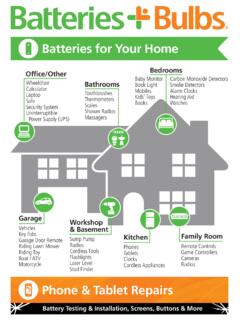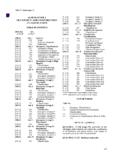Transcription of Safety Data Sheet (SDS) Sealed Lead Acid: AGM …
1 Ascent Battery Supply, LLC 1325 Walnut Ridge Drive Hartland, WI 53029 SAFET Y DAT A Sheet (SDS) Sealed LEAD AC I D: AGM The information and recommendations below are believed to be accurate at the date of document preparation. Ascent Battery Supply, LLC makes no warranty or merchantability or any other warranty, express or implied, with respect to this information and assumes no liability resulting from its use. This SDS provides guidelines for safe use and handling of product. It does not, and cannot, advise all possible situations. All specific uses of this product must be evaluated by the end user to determine if additional Safety precautions should be taken. The following information is provided as a courtesy to Ascent customers. SEC T I ON 1 I DEN T I FI CAT I ON Product Name AGM Battery: Stand-By, UPS, High-Rate, Telecomm Common Name(s) Absorbed Glass Mat(AGM) - Battery Synonyms SLA, VRLA, AGM, Absorbed Glass Mat, Sealed Recombinant DOT Description Wet Battery, non-spillable Chemical Name Sealed Lead Acid Battery, Secondary Battery Distributed By Ascent Battery Supply, LLC Address 1325 Walnut Ridge Drive, Hartland, WI 53029 Emergency number CHEMTREC 1-800-424-9300 International Emergency Number CHEMTREC +1 703-741-5970 (Collect) SEC T I ON 2 HAZARD(S) Hazard Statements Normal Conditions Under normal operating conditions, this product poses no health hazard.
2 Unusual Fire and Explosion Hazards Hydrogen and oxygen gases are produced in the cells during normal battery operation and may increase fire risk in poorly ventilated areas (hydrogen is flammable and oxygen supports combustion). These gases enter the air through the vent caps. To avoid the chance of fire or explosion, keep sparks and other sources of ignition away from the battery. Electrical Safety Battery terminals can be short circuited. Health Hazards Lead and Lead Compounds: Isolated exposure to dust or fumes can cause respiratory and eye irritation. Chronic exposure can cause kidney and nervous system damage; anemia and damage to the reproductive system. Ingestion may cause abdominal pain, nausea, vomiting, diarrhea, and severe cramping. Additional Information No health effects are expected related to normal use of this product as sold.
3 SEC T I ON 3 C OMPOSI TI ON Chemical Name CAS No. Percentage % Lead/Lead Compounds 7439-92-1 50-75 Sulfuric Acid 7664-93-9 5-20 Tin 7440-31-5 0-1 Antimony 7440-36-0 Calcium 7440-70-2 Arsenic 7440-38-2 ABS/Polypropylene 9003-56-9/9003-07-0 2-10 AGM Separator n/a 3-4 SEC T I ON 4 FI RST AID MEASURES Inhalation Electrolyte: Remove from exposure, move to fresh air immediately. If not breathing, give artificial respiration. If breathing is difficult, give oxygen. Consult a physician immediately. Lead: Remove from exposure, gargle, wash nose and lips. Consult physician immediately. Eyes Contact Electrolyte and Lead: Flush eyes immediately with large amounts of water for at least 15 minutes, lifting lower and upper eyelids occasionally. Consult a physician immediately. Skin Contact Electrolyte: Flush affected area(s) with large amounts of water using deluge emergency shower, if available, shower for at least 15 minutes.
4 Remove contaminated clothing, including shoes. Consult a physician if skin irritation appears. Wash contaminated clothing before reuse. Discard contaminated shoes. Lead: Wash immediately with soap and water. Ingestion Do NOT induce vomiting or aspiration into the lungs may occur and can cause permanent injury or death. Give large quantities of water. Never give anything by mouth to an unconscious person. Consult a physician immediately. SEC T I ON 5 FI RE-FI GHT I N G MEASURES Flash Point N/A Auto Ingestion No data Available Extinguisher Media - Dry chemical type extinguishers or water. Special Fire-Fighting Procedures - Full protective clothing and NIOSH-approved self-contained breathing apparatus with full face shield. Extinguish fire with agent suitable for surrounding combustible materials. Cool exterior of battery if exposed to fire to prevent or stop release of lead chemicals and fumes.
5 Firefighting runoff and dilution water may be toxic and corrosive. Do not use carbon dioxide directly on cells. SEC T I ON 6 ACC I DENTAL RELEASE MEASURES Lead dust should be vacuumed or wet swept into a DOT approved container. Use controls that minimize escaping or fugitive emissions. Do not use compressed air. SEC T I ON 7 HAN DLI N G AN D ST ORAG E Store batteries in a cool, dry, well-ventilated area: separate from incompatible materials and any activities that can generate flames, sparks, or heat. Use an insulating material, such as cardboard, between stacked layers of batteries. Keep all metallic articles that could short the terminals away from batteries. Use insulated tools only. Follow all installation instructions and diagrams when installing or maintaining battery systems. Handle cautiously; avoid contact with eyes and skin.
6 SEC T I ON 8 EX POSURE C ON T ROLS/ PERSON AL PROT EC T I ON Respiratory Protection (NIOSH/MSHA approved) - None required under normal handling conditions. During battery formation (high-rate charge condition), acid mist can be generated which may cause respiratory irritation. Also, if acid spillage occurs in a confined space, exposure may occur. If irritation occurs, wear a respirator suitable for protection against acid mist. Eye Protection - If battery case is damaged, use chemical goggles or face shield worn over Safety glasses. Skin Protection - If battery case is damaged, use rubber or plastic acid-resistant gloves with elbow-length gauntlet, acid-resistant apron, clothing and boots. Safety shoes are recommended when handling batteries. All footwear must meet requirements of ANSI SEC T I ON 9 PHYSI C AL/C HEMI C AL PROPERT I ES Boiling Point Electrolyte: 110 C (230 F) Melting Point Lead: 327 C (621 F) Vapor Pressure Electrolyte: 10 mmHg Vapor Density >1 Specific Gravity (H2O=1) Electrolyte: Solubility in Water Electrolyte: 100% Evaporation Rate Acid: <1 (n-BuAc=1) Reactivity in Water NA Auto-Ignition Temperature 580 C (Hydrogen) Odor Threshold Not Applicable Viscosity (poise @ 25 C) Not Available Partition Coefficient NA Decomposition Temperature Not Available Flash Point 259 C (Hydrogen) Appearance and Odor Electrolyte: clear liquid; acidic odor Case: case with terminals, odorless SEC T I ON 1 0 ST AB I LITY & REAC TI VI T Y Stability - This product is stable under normal conditions at ambient temperature.
7 Avoid sparks, other sources of ignition, and electrical shorting. I N C O M P A T I B I L I T Y ( M A TE R I A L S T O A V O I D ) Lead/Lead Compounds: potassium (K), carbides, sulfides, peroxides, phosphorus (P), and sulfur Battery Electrolyte (Acid): combustible materials, strong reducing agents, most metals, carbides, organic materials, chlorates, nitrates, picrate and fulminates. SEC T I ON 1 1 T OX I C OLOG I C AL IN FORMAT I ON Threshold Limit Value: OSHA Air Exposure Limits (ug/ m ) Lead/Lead Compound: 50 Tin: 2000 Dilute Sulfuric Acid: 1000 R O U T ES A N D M E T HO D S OF EN T R Y - Inhalation - Acid mist from formation process may cause respiratory irritation. Skin Contact Acid may cause irritation, burns and/or ulceration. Eye Contact - Acid may cause severe irritation, burns, cornea damage and/or blindness.
8 Ingestion - Acid may cause irritation of mouth, throat, esophagus, and stomach. S I G N S A N D S Y M P T O M S OF O V ER EX P O S U R E Acute Effects - Over exposure to lead may lead to loss of appetite, constipation, sleeplessness and fatigue. Over exposure to acid may lead to skin irritation, corneal damage of the eyes and upper respiratory system. Chronic Effects - Lead and its components may cause damage to kidneys and nervous system. Acid and its components may cause lung damage and pulmonary conditions. M E D I C A L C O N D I T I O N S GEN ER A L L Y A G G R A V A T ED B Y EX P O S U R E Potential to Cause Cancer: The International Agency for Research on Cancer has classified "strong inorganic acid mist containing sulfuric acid" as a Category1 carcinogen, a substance that is carcinogenic to humans.
9 This classification does not apply to liquid forms of sulfuric acid or sulfuric acid solutions contained within a battery. Inorganic acid mist is not generated under normal use of this product. Misuse of the product, such as overcharging, may however result in the generation of sulfuric acid mist. SEC T I ON 1 2 EC OLOGIC AL I N FORMAT I ON Hazardous Decomposition Products Lead/Lead Compounds: Oxides of lead and sulfur. Battery Electrolyte (Acid): Hydrogen, sulfur dioxide, and sulfur trioxide. SEC T I ON 1 3 DI SPOSAL Waste Disposal Method Battery electrolyte (acid): Neutralize as above for a spill, collect residue, and place in a drum or suitable container. Dispose of as hazardous waste. Spent batteries: Send to lead smelter for reclamation following applicable Federal, State and local regulations.
10 Product can be recycled along with automotive (SLI) lead acid batteries. Do not flush lead contaminated acid to sewer. SEC T I ON 1 4 T RAN SPORT DOT: Lead Acid batteries that are classified as non-spillable have been tested and meet the non-spillable criteria listed in CFR 49, (f) and (d) (1). Non-spillable batteries are excluded from CFR 49, Subchapter C requirements, provided that the following criteria are met: (1) The batteries must be securely packed in strong outer packaging and meet the requirements of CFR 49 ; (2) The batteries' terminals must be protected against short circuit; and (3) Each battery and their outer packaging must be plainly and durably marked "NONSPILLABLE" or NONSPILLABLE BATTERY" The exception from CFR 49, Subchapter C means shipping papers need not show proper shipping name, hazard class, UN number, and packing group.





